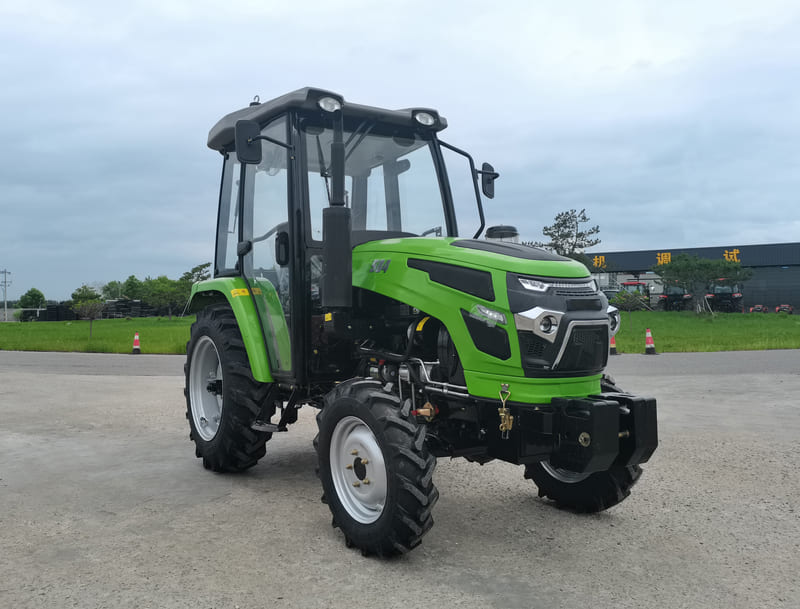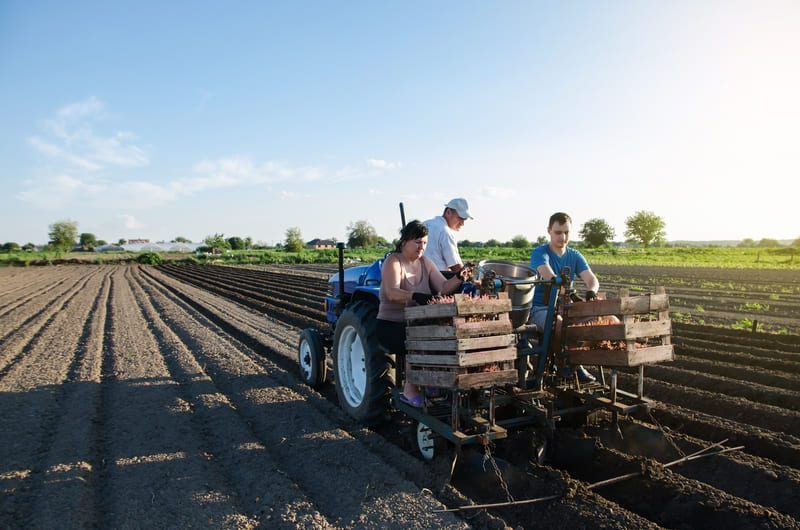Utility tractors are like the Swiss Army knife of the farming world, packing versatility and efficiency into one powerful package.
Utility tractors are a top pick for modern farmers due to their unmatched versatility, moderate horsepower, and budget-friendly nature. They handle tasks from tilling to mowing and transporting, making them perfect for small to medium farms.
When I first stepped into the world of farming, the vast array of tractor options was overwhelming. But the utility tractor quickly stood out for its adaptability. Think of it as your farming best friend—reliable, flexible, and always ready to take on a new challenge. Whether you're managing a vineyard or a small family farm, these machines are designed to handle a broad spectrum of tasks with ease.
Still, it's crucial to weigh your unique needs against what utility tractors offer. In this guide, I'll walk you through the key benefits and features of utility tractors, compare them with other types, and share some tips to help you decide if they're the right fit for your farming operation.
Utility tractors are the most versatile for small farms.True
Utility tractors can perform various tasks, ideal for small farms.
Utility tractors are the most powerful option available.False
They offer mid-range power, not the highest among tractor types.
Why Are Utility Tractors So Adaptable for Farm Work?
Growing up on my family farm, I quickly learned that utility tractors are like the Swiss Army knife of farming tools. They're not just machines; they're partners in getting the work done efficiently.
Utility tractors stand out for their versatility, thanks to their ability to handle a range of attachments like loaders, mowers, and sprayers. Their balanced power and compact size make them perfect for varied tasks on small to medium-sized farms.

Power and Size Advantages
I remember the first time I took the wheel of our trusty utility tractor. It was a crisp morning, and I felt like I was about to embark on an adventure across our farm's landscape. These tractors typically pack 40 to 100 horsepower, striking that sweet spot between power and efficiency. They’re perfect for farms like ours, where maneuverability is crucial but performance can't be compromised. Their size means they navigate through our orchard’s narrow lanes without a hitch.
Attachment Compatibility
One thing I love about our utility tractor is its adaptability. Whether it's attaching a loader to clear debris after a storm or swapping it out for a mower when the grass gets a bit too wild, it’s always ready for the next task. With three-point hitches and PTOs (Power Take-Offs), these tractors are like chameleons, seamlessly adjusting to whatever job we throw their way.
| Attachment | Primary Function |
|---|---|
| Loader | Moving materials |
| Mower | Cutting grass |
Cost Efficiency
When we upgraded to our current utility tractor, the lower cost was a big selling point. Not only was the upfront cost reasonable, but its fuel consumption turned out to be impressively low. It’s hard not to appreciate a machine that saves you money while boosting productivity. Learn more about cost-effective tractors1.
Ease of Use
Operating our utility tractor feels intuitive, almost like it's an extension of myself. With features like hydrostatic transmissions and power steering, it's no wonder even my youngest can handle it with ease. Long days in the field don't feel as daunting with such ergonomic designs. Explore user-friendly tractor models2.
Utility tractors range from 40 to 100 horsepower.True
Utility tractors typically offer this horsepower range, balancing power and efficiency.
Utility tractors cannot use three-point hitches.False
Utility tractors often come with three-point hitches for attachment compatibility.
What are the key differences between utility and compact tractors?
When it comes to tractors, making the right choice can change everything on your farm. Dive into the world of utility and compact tractors to see which one fits your lifestyle best.
Utility tractors boast more power and size for heavy-duty tasks, while compact tractors excel in smaller, tight spaces with their maneuverability and efficiency. Each has its own strengths, making the right choice dependent on your specific needs.

Size and Power
Looking back at my own journey in farming, I remember the first time I had to choose between a utility tractor and a compact one. It felt like deciding between a trusty pickup truck and a zippy little car.
Utility Tractors: These are the workhorses of the tractor world, boasting 40 to 100 horsepower. Whether you're tilling fields or hauling heavy loads, these tractors are built for serious jobs. Their larger build means they can tackle demanding tasks with ease. I remember a friend who used his utility tractor to clear an entire field of rocks—it was a game-changer for him.
Compact Tractors: On the flip side, if you’re working in a smaller area or need something nimble, compact tractors are your best bet. With up to 40 horsepower, they are ideal for lighter duties like mowing or landscaping. I once helped a neighbor with orchard maintenance using a compact tractor—it was perfect for weaving through rows of trees without disturbing them.
Versatility and Attachments
Reflecting on my past experiences, versatility is key in farming.
Utility Tractors: They’re like Swiss Army knives when it comes to attachments. From loaders3 to sprayers and backhoes, these machines can do it all. I once managed to plow and plant an entire acre in a day, thanks to the variety of implements my utility tractor could handle.
Compact Tractors: Although they support fewer attachments, they shine in specialized tasks with tools like mowers4 or tillers. I’ve always found them to be incredibly efficient for maintaining my garden.
Cost and Efficiency
Budgeting for a tractor is never easy, but knowing the costs upfront helps.
| Tractor Type | Cost | Fuel Efficiency |
|---|---|---|
| Utility | Higher | Moderate |
| Compact | Lower | Higher |
While utility tractors require a higher initial investment, their ability to perform various tasks can pay off over time. On the other hand, compact tractors offer a wallet-friendly price and better fuel economy, making them perfect for ongoing operations.
Space and Maneuverability
Space was always a consideration when I worked on smaller plots.
Utility Tractors: They do require more room but offer stability for heavy-duty work. I recall how my utility tractor felt rock-solid even on rough terrains.
Compact Tractors: If you’re like me and often find yourself in tight spots, their smaller size is a blessing. They can navigate narrow paths with precision—something that’s saved me hours of work time.
Both types of tractors have their own place in the farming world. Understanding these differences can help you make the best choice for your needs. It's all about balancing what you need with what your land requires. For more detailed insights, checking out tractor specifications5 will certainly guide you further.
Utility tractors have up to 40 horsepower.False
Utility tractors typically range from 40 to 100 horsepower.
Compact tractors offer better fuel efficiency than utility tractors.True
Compact tractors are more fuel-efficient, making them economical for ongoing use.
Are Utility Tractors Cost-Effective for Small to Medium Farms?
Picture yourself on a crisp morning, the sun rising over your fields, as your utility tractor roars to life, ready to tackle the day’s tasks.
Utility tractors are a smart investment for small to medium farms due to their adaptability, reasonable price points, and cost-efficient operation. They seamlessly handle diverse jobs, conserving both time and money while ensuring consistent productivity.

Versatility Across Farm Tasks
I remember the first time I watched a utility tractor in action—it was like seeing a Swiss Army knife come to life on the farm. These machines are engineered to perform a wide array of activities: tilling, plowing, transporting materials, and more. The beauty lies in their adaptability; they eliminate the need for multiple specialized machines, saving both money and precious space in the barn. For instance, using a utility tractor6 with a loader attachment is like having an extra set of hands to move bulk materials effortlessly across the farm.
Pricing and Cost Analysis
When I was considering my options, the affordability of utility tractors stood out. They typically sit comfortably between large garden tractors and high-horsepower models in terms of cost. This makes them accessible for those of us managing moderate budgets. Plus, their fuel efficiency is a game-changer; they consume significantly less compared to larger counterparts, which means operational costs stay low over time. Fuel efficiency comparisons7 only reinforce these potential savings.
| Type | Horsepower | Average Cost |
|---|---|---|
| Utility Tractor | 40-100 | $25,000 - $60,000 |
| Row-Crop Tractor | 100+ | $75,000+ |
Compatibility with Attachments
Another feature I find incredibly useful is the three-point hitch and PTO (Power Take-Off) system most utility tractors boast. This compatibility means you can attach various implements without buying entirely new equipment each time. Whether it’s a post-hole digger or a mower, these attachments transform your tractor into a multifunctional tool, enhancing its value exponentially.
Space Efficiency and Maneuverability
Living on a farm with tight spaces, I appreciate how compact and maneuverable utility tractors are. They easily navigate barns and weave between rows of crops, which is especially useful in orchards and vineyards8, where every inch of space counts.
Ease of Operation
Modern utility tractors come loaded with user-friendly features like hydrostatic transmissions and ergonomic cabs. I’ve found these enhancements significantly reduce operator fatigue, making long working days feel less daunting. Ergonomic tractor designs9 ensure comfort and efficiency, helping me stay productive without unnecessary strain.
By reflecting on these facets, I've realized that utility tractors offer an impressive balance of cost-efficiency and functionality, perfectly aligning with my farm’s needs without sacrificing productivity.
Utility tractors reduce the need for multiple machines.True
Utility tractors can perform various tasks, reducing the need for specialized equipment.
Utility tractors have higher operational costs than row-crop tractors.False
Utility tractors are more fuel-efficient, leading to lower operational costs.
What Attachments Can Be Used with Utility Tractors?
Have you ever wondered just how many jobs a utility tractor can handle with the right attachments?
Utility tractors can transform into multi-tasking machines by adding attachments like front loaders, backhoes, mowers, tillers, and post-hole diggers. These implements expand the tractor's capabilities, making it invaluable for farming, landscaping, and construction projects.

Front Loaders and Backhoes
Let me tell you about the time I was knee-deep in a landscaping project and realized my tractor could do more than just plow fields. With a front loader attachment, it became my go-to for hauling dirt and gravel, saving me countless hours. And when I needed to dig trenches for irrigation, the backhoe was a lifesaver.
- Front Loaders: Essential for loading materials into trucks or bins.
- Backhoes: Perfect for small-scale construction projects.
Mowers and Tillers
I remember the first time I attached a mower to my tractor. It was like giving my field a much-needed haircut. My neighbors often complimented the pristine look of my lawns after using a finishing mower. As for tillers, they became indispensable during planting season, turning tough soil into a soft bed ready for seeds.
| Attachment Type | Function |
|---|---|
| Rotary Mowers | Efficient grass cutting over large areas. |
| Finishing Mowers | Provide a manicured lawn finish. |
| Tillers | Break and prepare soil for planting. |
Post-Hole Diggers and Blades
Fencing projects became less daunting once I discovered the power of post-hole diggers. No more wrestling with manual tools! And when winter came around, a blade attachment made clearing snow an easy task.
- Post-Hole Diggers: Drill deep holes efficiently.
- Blades: Versatile in grading soil and managing snow removal.
Sprayers and Seeders
Sprayers were a game-changer for protecting crops with pesticides, while seeders took the guesswork out of planting, ensuring even distribution of seeds and boosting productivity.
- Sprayers: Available in different sizes to suit farm needs.
- Seeders: Offer precision in sowing seeds evenly.
Specialty Attachments
Exploring specialty attachments opened up new possibilities for me. Whether it was vineyard equipment or orchard sprayers, there seemed to be a tool for every unique need on my farm.
When picking attachments, I learned the importance of ensuring they match my tractor's power output and three-point hitch system. This compatibility is key to keeping everything running smoothly and prolonging the life of both my tractor and its tools.
Front loaders are used for trenching.False
Front loaders are used for moving materials, not trenching.
Post-hole diggers are essential for fencing.True
Post-hole diggers efficiently drill holes needed for fence posts.
How Does the Size of a Utility Tractor Affect Its Performance?
Picture this: you're standing in the middle of your farm, eyeing those vast fields and wondering how on earth you're going to tackle it all. The answer might just be in the size of your utility tractor.
The size of a utility tractor is crucial as it determines maneuverability, power, and task handling ability. Smaller tractors shine in agility, while larger ones offer enhanced power and lifting capacity for demanding tasks.

Maneuverability and Accessibility
I remember the first time I tried squeezing my tractor between the rows in my vineyard10. It felt like threading a needle with a rope! That's when I realized smaller tractors could be a lifesaver in tight spots. They weave through narrow paths like they were built for it, making them perfect for orchards or vineyards where precision is everything. Larger tractors, however, are more at home in wide open fields. They’re like gentle giants—strong but not always nimble enough for tight corners or low-clearance areas.
Power and Lifting Capacity
Let's talk about power. Larger tractors often come packed with high horsepower, which is amazing when you’ve got heavy-duty jobs lined up. Imagine trying to lift a massive hay bale with a tractor that’s not up to the task; it’s like asking your cat to pull a sled! On the flip side, if your work involves lighter tasks, a smaller tractor could be your best buddy. It’s all about matching the tractor’s muscle to your farm's needs.
Compatibility with Attachments
Have you ever tried fitting a square peg into a round hole? That’s what it feels like when your tractor isn’t compatible with the attachments you need. Smaller models handle basic tools like mowers or seeders with ease. But if you're looking to dig post holes or operate a baler, you’ll need a larger tractor that can carry the load.
Here's a quick comparison table to illustrate:
| Tractor Size | Compatible Attachments |
|---|---|
| Small | Mowers, Tillers, Sprayers |
| Medium | Loaders, Post-Hole Diggers |
| Large | Balers, Heavy-Duty Plows, Backhoes |
Farmers should evaluate their attachment needs to ensure their chosen tractor size aligns with their operational goals.
Operational Cost Implications
Every time I filled up the fuel tank on my big tractor, I felt it in my wallet. Larger models drink up more fuel and can be costlier to maintain, though they do bring efficiency for larger operations. Meanwhile, smaller tractors are like fuel-sipping compacts—they're perfect for small to medium farms and help keep expenses down without compromising on necessary functions.
In summary, selecting the appropriate utility tractor size involves balancing power needs with maneuverability and operational costs. Evaluating specific farm tasks11 and conditions will guide buyers towards the optimal choice for enhanced productivity and efficiency.
Smaller tractors excel in tight spaces.True
Smaller tractors are more maneuverable, ideal for orchards and vineyards.
Larger tractors consume less fuel than smaller ones.False
Larger tractors generally consume more fuel due to higher power output.
Can a Utility Tractor Meet Your Specialized Farming Needs?
Imagine finding the perfect tool that adapts to every unique challenge on your farm. Is a utility tractor that versatile? Let's explore its capabilities and see if it truly meets the demands of specialized farming.
Utility tractors are perfect for specialized farming because they adapt easily to various tasks. Their versatility, compact size, and ability to handle different attachments make them ideal for orchards, vineyards, and similar settings.

Discovering Versatility in Everyday Tasks
When I first ventured into farming, the sheer diversity of tasks was overwhelming. That's when the utility tractor became my go-to companion. Imagine being able to attach a sprayer for morning misting and then switching to a loader by afternoon. The beauty of these tractors is their ability to adapt swiftly to changing needs, making my day-to-day operations smoother and more efficient.
Navigating Tight Spaces with Ease
For those working in orchards or vineyards, you know how crucial it is to have equipment that respects the delicate layout of your crops. I remember the first time I managed to squeeze between tight rows without any crop damage—it was a game-changer! The compact design of utility tractors ensures you can maneuver through even the most cramped spaces with grace.
Balancing Cost with Performance
Cost is always a significant factor. I found utility tractors offered that sweet spot between price and performance. They're generally more affordable than their high-horsepower counterparts, both in purchase and running costs, which was a relief for my budget.
| Feature | Benefit |
|---|---|
| Versatility | Handles multiple attachments |
| Compact Size | Maneuvers in tight spaces |
| Cost-Effectiveness | Lower operating and purchase costs |
Enhancing Flexibility with Attachments
Equipped with features like three-point hitches and Power Take-Offs (PTOs), utility tractors can operate a variety of implements. This capability enhances their suitability for specialized farming. Farmers can attach equipment such as mowers, tillers, and post-hole diggers based on their specific needs.
A User-Friendly Experience
I can’t stress enough how important ease of use is, especially during long hours on the field. Modern utility tractors often come with comfortable cabins and intuitive controls. Features like power steering made my life easier by reducing fatigue—an essential aspect when you're working under the hot sun all day.
For detailed information on compatible attachments for utility tractors12, consider exploring different manufacturers and models to find one that suits your farm's needs best. Specialized farming requires specific tools, and utility tractors often provide the flexibility needed to meet those demands.
Utility tractors are ideal for large-scale farming operations.False
Utility tractors are more suited for smaller, specialized tasks due to their compact size.
Utility tractors can use a variety of attachments for different tasks.True
Equipped with three-point hitches and PTOs, they support multiple implements.
Conclusion
Utility tractors are versatile, budget-friendly machines ideal for small to medium farms, capable of handling diverse tasks efficiently with various attachments and moderate horsepower.
-
This link offers information on how utility tractors can be a budget-friendly option for farmers. ↩
-
Explore tractor models designed with ease of use in mind, perfect for operators of all experience levels. ↩
-
Discover how loader attachments enhance the functionality of utility tractors for heavy lifting and material handling. ↩
-
Explore mower attachments suitable for compact tractors to optimize your lawn care tasks. ↩
-
Access detailed comparisons of tractor models to find one that matches your specific farming needs. ↩
-
Explore the wide range of attachments available for utility tractors that increase their versatility on small farms. ↩
-
Learn about fuel savings when using utility tractors instead of larger models. ↩
-
Discover how utility tractors are particularly suited for use in orchards and vineyards. ↩
-
Understand the ergonomic advancements in modern utility tractors that enhance operator comfort. ↩
-
Explore how smaller tractors improve efficiency in vineyards by offering superior maneuverability among rows. ↩
-
Discover typical tasks that benefit from using utility tractors to determine which size fits your agricultural needs. ↩
-
Explore various attachments that enhance the functionality of utility tractors, tailored for different farming needs. ↩



